-
 Tomb of Sultan Salahuddin (IIIF)
Tomb of Sultan Salahuddin (IIIF)
-
 Tomb of Sultan Ali Mughayat Syah (IIIF)
Tomb of Sultan Ali Mughayat Syah (IIIF)
-
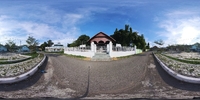 Kandang XII
Kandang XII N/A
-
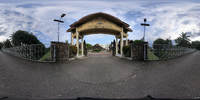 Museum Aceh
Museum Aceh N/A
-
A Major Note
-
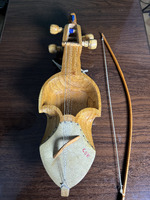 Sarangi
Sarangi Sarangi is a bowed string instrument, embodies the spirit of Nepali folk music. It possesses a distinctive, mellow sound due to its unique construction and playing techniques. The Nepali Sarangi is played at specific pitches to create a characteristic harmonic foundation. It is played with a curved bow, the instrument’s captivating melodies typically accompany the soulful voices of ”Gaine” singers from the Gandharva community. These songs, rich in cultural significance, often narrate historical events, social issues, and everyday life, serving as a powerful medium for cultural transmission and social commentary.
-
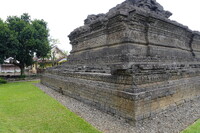 Jago Temple
Jago Temple Candi Jago, located in Tumpang, Malang, East Java, Indonesia, is a 13th-century Hindu-Buddhist temple built during the Singhasari Kingdom. It is believed to have been constructed as a memorial for King Wisnuwardhana, a ruler of Singhasari, around 1268–1280 CE. The name "Jago" is thought to derive from the ancient Javanese word "Jajaghu," which means "glorious," reflecting its significance as a spiritual and cultural landmark. The temple's architecture and carvings illustrate the syncretism of Hindu and Buddhist influences that characterized the religious practices of the time.Physically, Candi Jago is notable for its unique stepped-pyramid design, a departure from the more vertical structures of earlier temples. The base of the temple is square, measuring approximately 23 meters on each side, with a terraced design leading to a now-missing main chamber and roof. Its walls are adorned with intricate bas-reliefs depicting scenes from Hindu epics such as the Mahabharata and Ramayana, as well as Buddhist narratives like the Jataka tales. These carvings not only highlight the temple's artistic mastery but also provide a glimpse into the moral and spiritual values of the Singhasari period.
Despite its historical significance, much of Candi Jago is in a state of ruin due to centuries of weathering and human intervention. The roof and upper structures have been lost, and some carvings have deteriorated. Nevertheless, restoration efforts have helped preserve the remaining elements, ensuring that visitors can still appreciate its beauty and historical importance. Today, Candi Jago serves as a vital link to Indonesia’s rich cultural heritage, attracting tourists, researchers, and spiritual seekers alike.
-
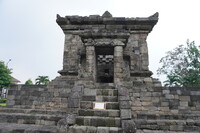 Badut Temple
Badut Temple Candi Badut, located in Malang, East Java, Indonesia, is a small yet historically significant Hindu temple believed to have been built in the 8th century during the era of the Kanjuruhan Kingdom. As one of the oldest temples in East Java, it holds great importance in understanding the early spread of Hindu culture and architecture in the region. The temple’s structure is relatively simple, with a square base and a central chamber (cella) that once housed a Lingga-Yoni, symbolizing the worship of Shiva, a key deity in Hinduism. Although parts of the temple have been damaged or eroded over time, the remaining carvings and architectural elements reflect the early Javanese style of stone construction, characterized by minimalistic yet meaningful designs.The temple’s name, “Badut,” which translates to “clown” in modern Indonesian, is intriguing, though its connection to the temple's purpose or history is unclear. Located in the Tidar area, on the western outskirts of Malang, Candi Badut is surrounded by lush greenery, providing a tranquil environment that enhances its spiritual and historical atmosphere. Efforts have been made to restore and preserve the site, making it a popular destination for both tourists and researchers. Its accessibility and cultural significance make Candi Badut not only a treasure of Malang’s heritage but also an important link to the early history of Hinduism in Java.
-
 Tuanku Sultan Zainal Abidin
Tuanku Sultan Zainal Abidin N/A
-
 King of Women Darussalam
King of Women Darussalam N/A
-
 Sultan Alauddin Mahmudsyah
Sultan Alauddin Mahmudsyah N/A
-
 Daughter Son King Bangka Hulu
Daughter Son King Bangka Hulu N/A
-
 Tomb of Sultan Yusuf
Tomb of Sultan Yusuf The tomb of Sultan Yusuf, who is mentioned on his tombstone: died Tuesday 27 Rabi'ul Akhir 987 H = Tuesday 23 June 1579 AD.
-
 Tomb of Sultan Abdullah
Tomb of Sultan Abdullah N/A
-
 Tomb of Muhammad Syah Naim
Tomb of Muhammad Syah Naim The tomb of Muhammad Syah Naim, this figure is the son of Sultan Alaiddin Al-Qahar or the grandson of Sultan Ali Mughayat Syah who died on 27 Dhul Hijja 978 H or 1571 AD.
-
 Tomb of Sultan Ghori
Tomb of Sultan Ghori Sultan Ghori, the son of Sultan Alaiddin Riayat Syah Al-Qahar died in Dhul Hijjah 984 H or 1576 AD.
-
 Tomb of Sultan Ali Ri'ayat Syah
Tomb of Sultan Ali Ri'ayat Syah The tomb of the son of the 3rd successor (sultan number 3), 'Ali Ri'ayat Shah, who is mentioned on the tombstone: died on Monday, 12 Rabi'ul Awal 987 H = Monday, June 8, 1579 AD.
-
 Tomb of Sultan Alauddin Al-Qahhar
Tomb of Sultan Alauddin Al-Qahhar The tomb of Alauddin Al-Qahhar, on the tombstone is mentioned: died on Friday 8 Jumadil Awal 979 H = Friday 28 September 1571 AD.
-
 Tomb of Sultan Salahuddin
Tomb of Sultan Salahuddin The tomb of Sultan Salahuddin (mentioned on the tombstone) died on Saturday 23 Syawwal 955 H = Sunday 25 November 1548 AD.
-
 Tomb of Sultan Ali Mughayat Syah
Tomb of Sultan Ali Mughayat Syah Tomb of Ali Mughayat Syah died on Sunday, the 12th of Doelhidjah 936 H = Sunday, August 7, 1530 AD.
 Tomb of Sultan Salahuddin (IIIF)
Tomb of Sultan Salahuddin (IIIF)  Tomb of Sultan Ali Mughayat Syah (IIIF)
Tomb of Sultan Ali Mughayat Syah (IIIF)  Kandang XII N/A
Kandang XII N/A Museum Aceh N/A
Museum Aceh N/A Sarangi Sarangi is a bowed string instrument, embodies the spirit of Nepali folk music. It possesses a distinctive, mellow sound due to its unique construction and playing techniques. The Nepali Sarangi is played at specific pitches to create a characteristic harmonic foundation. It is played with a curved bow, the instrument’s captivating melodies typically accompany the soulful voices of ”Gaine” singers from the Gandharva community. These songs, rich in cultural significance, often narrate historical events, social issues, and everyday life, serving as a powerful medium for cultural transmission and social commentary.
Sarangi Sarangi is a bowed string instrument, embodies the spirit of Nepali folk music. It possesses a distinctive, mellow sound due to its unique construction and playing techniques. The Nepali Sarangi is played at specific pitches to create a characteristic harmonic foundation. It is played with a curved bow, the instrument’s captivating melodies typically accompany the soulful voices of ”Gaine” singers from the Gandharva community. These songs, rich in cultural significance, often narrate historical events, social issues, and everyday life, serving as a powerful medium for cultural transmission and social commentary. Jago Temple Candi Jago, located in Tumpang, Malang, East Java, Indonesia, is a 13th-century Hindu-Buddhist temple built during the Singhasari Kingdom. It is believed to have been constructed as a memorial for King Wisnuwardhana, a ruler of Singhasari, around 1268–1280 CE. The name "Jago" is thought to derive from the ancient Javanese word "Jajaghu," which means "glorious," reflecting its significance as a spiritual and cultural landmark. The temple's architecture and carvings illustrate the syncretism of Hindu and Buddhist influences that characterized the religious practices of the time.Physically, Candi Jago is notable for its unique stepped-pyramid design, a departure from the more vertical structures of earlier temples. The base of the temple is square, measuring approximately 23 meters on each side, with a terraced design leading to a now-missing main chamber and roof. Its walls are adorned with intricate bas-reliefs depicting scenes from Hindu epics such as the Mahabharata and Ramayana, as well as Buddhist narratives like the Jataka tales. These carvings not only highlight the temple's artistic mastery but also provide a glimpse into the moral and spiritual values of the Singhasari period. Despite its historical significance, much of Candi Jago is in a state of ruin due to centuries of weathering and human intervention. The roof and upper structures have been lost, and some carvings have deteriorated. Nevertheless, restoration efforts have helped preserve the remaining elements, ensuring that visitors can still appreciate its beauty and historical importance. Today, Candi Jago serves as a vital link to Indonesia’s rich cultural heritage, attracting tourists, researchers, and spiritual seekers alike.
Jago Temple Candi Jago, located in Tumpang, Malang, East Java, Indonesia, is a 13th-century Hindu-Buddhist temple built during the Singhasari Kingdom. It is believed to have been constructed as a memorial for King Wisnuwardhana, a ruler of Singhasari, around 1268–1280 CE. The name "Jago" is thought to derive from the ancient Javanese word "Jajaghu," which means "glorious," reflecting its significance as a spiritual and cultural landmark. The temple's architecture and carvings illustrate the syncretism of Hindu and Buddhist influences that characterized the religious practices of the time.Physically, Candi Jago is notable for its unique stepped-pyramid design, a departure from the more vertical structures of earlier temples. The base of the temple is square, measuring approximately 23 meters on each side, with a terraced design leading to a now-missing main chamber and roof. Its walls are adorned with intricate bas-reliefs depicting scenes from Hindu epics such as the Mahabharata and Ramayana, as well as Buddhist narratives like the Jataka tales. These carvings not only highlight the temple's artistic mastery but also provide a glimpse into the moral and spiritual values of the Singhasari period. Despite its historical significance, much of Candi Jago is in a state of ruin due to centuries of weathering and human intervention. The roof and upper structures have been lost, and some carvings have deteriorated. Nevertheless, restoration efforts have helped preserve the remaining elements, ensuring that visitors can still appreciate its beauty and historical importance. Today, Candi Jago serves as a vital link to Indonesia’s rich cultural heritage, attracting tourists, researchers, and spiritual seekers alike. Badut Temple Candi Badut, located in Malang, East Java, Indonesia, is a small yet historically significant Hindu temple believed to have been built in the 8th century during the era of the Kanjuruhan Kingdom. As one of the oldest temples in East Java, it holds great importance in understanding the early spread of Hindu culture and architecture in the region. The temple’s structure is relatively simple, with a square base and a central chamber (cella) that once housed a Lingga-Yoni, symbolizing the worship of Shiva, a key deity in Hinduism. Although parts of the temple have been damaged or eroded over time, the remaining carvings and architectural elements reflect the early Javanese style of stone construction, characterized by minimalistic yet meaningful designs.The temple’s name, “Badut,” which translates to “clown” in modern Indonesian, is intriguing, though its connection to the temple's purpose or history is unclear. Located in the Tidar area, on the western outskirts of Malang, Candi Badut is surrounded by lush greenery, providing a tranquil environment that enhances its spiritual and historical atmosphere. Efforts have been made to restore and preserve the site, making it a popular destination for both tourists and researchers. Its accessibility and cultural significance make Candi Badut not only a treasure of Malang’s heritage but also an important link to the early history of Hinduism in Java.
Badut Temple Candi Badut, located in Malang, East Java, Indonesia, is a small yet historically significant Hindu temple believed to have been built in the 8th century during the era of the Kanjuruhan Kingdom. As one of the oldest temples in East Java, it holds great importance in understanding the early spread of Hindu culture and architecture in the region. The temple’s structure is relatively simple, with a square base and a central chamber (cella) that once housed a Lingga-Yoni, symbolizing the worship of Shiva, a key deity in Hinduism. Although parts of the temple have been damaged or eroded over time, the remaining carvings and architectural elements reflect the early Javanese style of stone construction, characterized by minimalistic yet meaningful designs.The temple’s name, “Badut,” which translates to “clown” in modern Indonesian, is intriguing, though its connection to the temple's purpose or history is unclear. Located in the Tidar area, on the western outskirts of Malang, Candi Badut is surrounded by lush greenery, providing a tranquil environment that enhances its spiritual and historical atmosphere. Efforts have been made to restore and preserve the site, making it a popular destination for both tourists and researchers. Its accessibility and cultural significance make Candi Badut not only a treasure of Malang’s heritage but also an important link to the early history of Hinduism in Java. Tuanku Sultan Zainal Abidin N/A
Tuanku Sultan Zainal Abidin N/A King of Women Darussalam N/A
King of Women Darussalam N/A Sultan Alauddin Mahmudsyah N/A
Sultan Alauddin Mahmudsyah N/A Daughter Son King Bangka Hulu N/A
Daughter Son King Bangka Hulu N/A Tomb of Sultan Yusuf The tomb of Sultan Yusuf, who is mentioned on his tombstone: died Tuesday 27 Rabi'ul Akhir 987 H = Tuesday 23 June 1579 AD.
Tomb of Sultan Yusuf The tomb of Sultan Yusuf, who is mentioned on his tombstone: died Tuesday 27 Rabi'ul Akhir 987 H = Tuesday 23 June 1579 AD. Tomb of Sultan Abdullah N/A
Tomb of Sultan Abdullah N/A Tomb of Muhammad Syah Naim The tomb of Muhammad Syah Naim, this figure is the son of Sultan Alaiddin Al-Qahar or the grandson of Sultan Ali Mughayat Syah who died on 27 Dhul Hijja 978 H or 1571 AD.
Tomb of Muhammad Syah Naim The tomb of Muhammad Syah Naim, this figure is the son of Sultan Alaiddin Al-Qahar or the grandson of Sultan Ali Mughayat Syah who died on 27 Dhul Hijja 978 H or 1571 AD. Tomb of Sultan Ghori Sultan Ghori, the son of Sultan Alaiddin Riayat Syah Al-Qahar died in Dhul Hijjah 984 H or 1576 AD.
Tomb of Sultan Ghori Sultan Ghori, the son of Sultan Alaiddin Riayat Syah Al-Qahar died in Dhul Hijjah 984 H or 1576 AD. Tomb of Sultan Ali Ri'ayat Syah The tomb of the son of the 3rd successor (sultan number 3), 'Ali Ri'ayat Shah, who is mentioned on the tombstone: died on Monday, 12 Rabi'ul Awal 987 H = Monday, June 8, 1579 AD.
Tomb of Sultan Ali Ri'ayat Syah The tomb of the son of the 3rd successor (sultan number 3), 'Ali Ri'ayat Shah, who is mentioned on the tombstone: died on Monday, 12 Rabi'ul Awal 987 H = Monday, June 8, 1579 AD. Tomb of Sultan Alauddin Al-Qahhar The tomb of Alauddin Al-Qahhar, on the tombstone is mentioned: died on Friday 8 Jumadil Awal 979 H = Friday 28 September 1571 AD.
Tomb of Sultan Alauddin Al-Qahhar The tomb of Alauddin Al-Qahhar, on the tombstone is mentioned: died on Friday 8 Jumadil Awal 979 H = Friday 28 September 1571 AD. Tomb of Sultan Salahuddin The tomb of Sultan Salahuddin (mentioned on the tombstone) died on Saturday 23 Syawwal 955 H = Sunday 25 November 1548 AD.
Tomb of Sultan Salahuddin The tomb of Sultan Salahuddin (mentioned on the tombstone) died on Saturday 23 Syawwal 955 H = Sunday 25 November 1548 AD. Tomb of Sultan Ali Mughayat Syah Tomb of Ali Mughayat Syah died on Sunday, the 12th of Doelhidjah 936 H = Sunday, August 7, 1530 AD.
Tomb of Sultan Ali Mughayat Syah Tomb of Ali Mughayat Syah died on Sunday, the 12th of Doelhidjah 936 H = Sunday, August 7, 1530 AD.